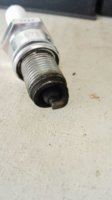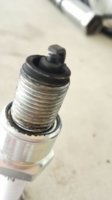Hi guys,
I have a '72 Yamaha xs2 650 that I restored. It has carburetors mikuni bs38 (clean new diaphragm), new tank, new air filter.
It also has new spark plugs but, they turn black and greasy on the ends. I believe the mixture is rich.
How do I fix that? Should I change the needle high (currently on position 3), or change the jet max, or what? Are there some outer screws I should adjust?
thanks
EDITED: I previously wrote bs34. Now I have corrected it. Thank you for pointing that out.


I have a '72 Yamaha xs2 650 that I restored. It has carburetors mikuni bs38 (clean new diaphragm), new tank, new air filter.
It also has new spark plugs but, they turn black and greasy on the ends. I believe the mixture is rich.
How do I fix that? Should I change the needle high (currently on position 3), or change the jet max, or what? Are there some outer screws I should adjust?
thanks
EDITED: I previously wrote bs34. Now I have corrected it. Thank you for pointing that out.


Last edited:



